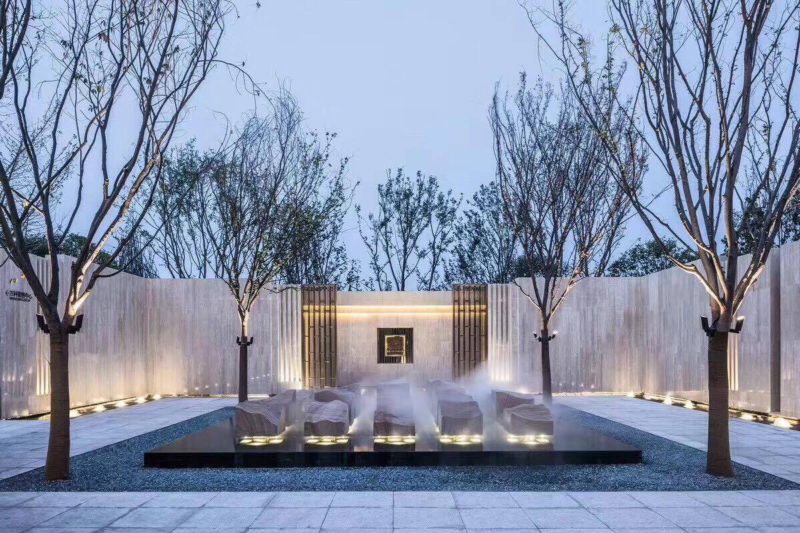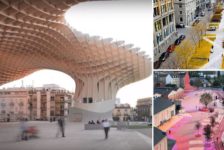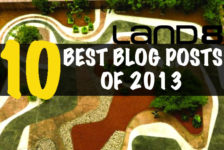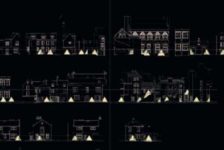Development in China is known to happen very quickly. Imagine the intensity of the design process from project conception to construction, which amplifies the importance of getting it right within a small time frame. Vanke Huafu Mansion Model District has done just that. Vanke Mansion Real Estate’s brand is one that promotes elegance and zen spirit of traditional Chinese mansions in a contemporary manner. The design direction was not only to design the low-density high quality residential development itself but also, more importantly, to design the main entrance area of a future residential community and the sales center within the ancient Chinese capital of Xi’an. Resolving practical issues of circulation satisfy the residents and visitors to the sales center. As the saying “You never get a second chance to make a good first impression” goes, the designers had a heavy task at hand.
What Makes Up the Zen Spirit of This Place?

There are many ways to approach this curiosity, but in this context we can pick up a sense of quiet rhythm. If a place could resemble the soft tones of a piano, this would be it. Users are led down to this quietness through a sequential approach. Circulation is divided via a series of courtyards, carefully arranged to take them down from a loud urban surrounding to a tranquil community area, transitioning from this bustling urban town to an exalted mansion.

This zen spirit is also represented through sculptures. The stone sculptures, which we will come to discuss later, add an earthy element to the place. They are solid-grounded and rooted so majestically that the place further radiates an inner peaceful quality.
Following the Traditional Ways

In the ancient times, common people lived in houses that shared one or two courtyards. Houses with three courtyards only belonged to nobles. To create this rich and majestic sense, the design follows the three courtyard tradition. This provides a grand entrance, bringing a sense of ritual. However, a courtyard atmosphere is also very communal and can be interpreted as a welcoming return to one’s home. The Gate, one of the three courtyards, is a luxury mansion with a repeated gateway entrance. The Courtyard, the second of the three, has a square water pool that reflects the sky and clouds.

The last courtyard, Mountain Hall, includes a 25-piece yellow sandstone mountain sculpture on a mirror of flowing water representing a metaphorical concept of Qinling Mountains.

Qinling Mountains sit adjacently to the south of Xi’an City. The notorious mountainous region, also known as the “Szechuan Alps,” create a natural boundary that divide the northern and southern parts of China, which brings more significance to this sculptural reference.

Around the doorway just after the courtyard series is a smaller courtyard for the marketing suite, which is used to showcase the district. This space, in particular, has been divided into several pieces. As it currently lacks activity, the area will be used for marketing but from abandoning the traditional vacant lawn design, it becomes a multi-functional space.

Thinking Ahead…
The first model house or “Outdoor Sanhao Mansion” is located after the courtyards. Being the furthest away from the urban town and as the last space, Sanhao Mansion is truly serene in nature and provides an exemplary outdoor space for future development.

The scale of the external area is designed to even ensure that the grass area can be mowed comfortably, including satisfying the requirements for a cultural gallery function for the future community. In order to strengthen the zen musicality within the courtyard, the designers have replaced traditional community planting with a floating evergreen planting pool, made out of a curved aluminum board. A group of mountain-cloud themed sculptures also sit within the middle.
A Subtle Kind of Beauty

There is a sense of purity and innocence within the project because a subtle language of poetic design starts to be formed by the materials and the rhythmic layout. An example is the “cloud” and “mountain” stone sculpture that is combined with the effect of fog and lighting to create a sensory experience.

You can catch the trunk and narrow branches of the young trees casting patterned shadows on the vertical and horizontal elements that narrate the transient beauty of nature and its cycles.


It is exciting to see the emergence of residential development of this quality — one that is contextually well considered and brings forward the design of outdoor areas to the forefront of the overall scheme. The clever conception of the project is building the sales center (a model home to allow prospective buyers to explore the design of home) first with exemplary spaces. This sets the standard and the notorious rhythmic tone for the future housing area.
The artistic sculptural quality of the scheme also contributes a charming layer of aesthetics that is not usually associated with residential developments. This is what makes it unique. This project makes the perfect “first impression” that is so important in today’s design world.

Project Information
Project Name: True Love, Vanke Huafu Mansion Model District
Project Address: No.4 Heyanqu Road, South Park Road, Xi’an City, Shanxi Province
Project Area: 5000 ㎡
Date: March, 2017
Completed Date: July, 2017
Developer: Vanke Real Estate
Design Firm: FLO Landscape Design Company
Design Team: Kai Fu, Lei Guo, Lixing Pan, Shiqian Luo, Jianhao Sun, Xiaoyin Wang, Shuyi Zhang
All images courtesy of FLO Landscape Design Company.
Published in Blog








Woodman336
These sales centers are common in China and most all look the same, but still good job though, it’s nice
Win Phyo
Hi Joshua, I see – I haven’t been to China yet so it’s interesting that you shared this.